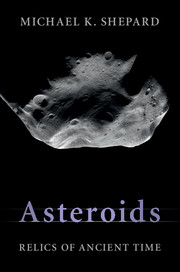Book contents
- Frontmatter
- Dedication
- Contents
- Preface
- Acknowledgements
- Brief list of asteroid and meteorite terms
- 1 It's a small world
- 2 A night at the zoo
- 3 It came from outer space
- 4 A day at the museum
- 5 The gambler's fallacy
- 6 Remembrance of things past
- 7 The ties that bind
- 8 Terra incognita
- 9 To your scattered bodies go
- 10 Scouts, sappers, and miners
- Glossary
- Bibliography
- Index
- References
7 - The ties that bind
Published online by Cambridge University Press: 05 May 2015
- Frontmatter
- Dedication
- Contents
- Preface
- Acknowledgements
- Brief list of asteroid and meteorite terms
- 1 It's a small world
- 2 A night at the zoo
- 3 It came from outer space
- 4 A day at the museum
- 5 The gambler's fallacy
- 6 Remembrance of things past
- 7 The ties that bind
- 8 Terra incognita
- 9 To your scattered bodies go
- 10 Scouts, sappers, and miners
- Glossary
- Bibliography
- Index
- References
Summary
Gin a body meet a body
Flyin' through the air.
Gin a body hit a body,
Will it fly? And where?
James Clerk Maxwell, Rigid Body Sings (1882)
FALSE DAWN
In the deserts of Arabia, the air is dry and the sky is an inky black. It's a perfect environment for studying the sky, and modern astronomy owes much to the Arab sky watchers of millennia past. One need only listen to the names we give to the brighter stars to hear the debt; Algol (the ghoul), Deneb (tail), Fomalhaut (mouth of the fish), and Rigel (foot) are all derived from Arabic. The depth and clarity of their dark skies also made some phenomena, overlooked by others, obvious to them.
Islam requires prayers five times per day. In a world with no clocks, the appropriate times were set by the position of the Sun. The first of these prayer times, Fajr, begins at dawn. But the Arabian sky watchers had often experienced a misleading light well before then – a false dawn. In a true dawn, sunlight spreads across the horizon, growing in intensity as the Sun approaches sunrise. In a false dawn, a cone of light, sometimes referred to as a wolf's tail, points upward from the horizon, and can occur hours before true sunrise. It is said that the Prophet Muhammad instructed his followers on ways to avoid being fooled by it. There is no mention of it by European astronomers until the late seventeenth century when it is discussed by Cassini. Subsequently, Europeans referred to the phenomenon as the zodiacal light, a faint glow that lies along the ecliptic – the same plane as the constellations of the zodiac. Only in the late nineteenth century did European astronomers come to realize that the false dawn of the Muslims was the same as the zodiacal light.
We now know the zodiacal light is caused by a cloud of fine dust, the zodiacal cloud, that encircles the Sun in the plane of the ecliptic.
- Type
- Chapter
- Information
- AsteroidsRelics of Ancient Time, pp. 191 - 218Publisher: Cambridge University PressPrint publication year: 2015



